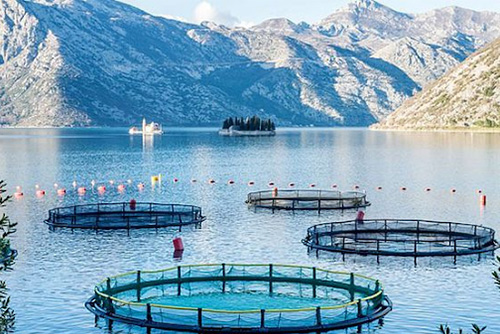
One of the crucial components in a recirculating aquaculture system, a biofilter helps in the control of ammonia levels as it is the site for biological nitrification. It helps in the creation of an environment where the microorganisms can break down the gasses, using the produced energy for their nourishment and reproduction. Thus, in aquaculture filtration, a biological filter is vital.
This explains the need of selecting the best-suited biofilter according to your needs and specifications for recirculating aquaculture or aquarium systems. It is a complex topic that needs thorough research and understanding before taking the next step.
Hence, we have carefully created this blog serving all the necessary information about biofilters, the steps involved in setting up a biofilter, the things you need to consider beforehand, and others.
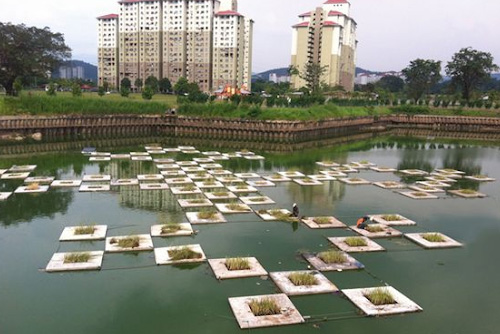
As stated earlier, a biological filter is a prime location where the biological nitrification takes place and is the most important part of the aquaculture filter. To start a biofilter means seeding and managing the nitrifying bacteria cells in the bio filter media.
Generally, the non-corrosive filter media are used for biofilters since they have a large surface area that allows more bacteria cells to be colonized resulting in a greater nitrification process. This in turn increases the feeding capacity which ultimately increases the efficiency of a biofilter.
Thus, a specific surface area or SSA has a great role to play in the functioning of a biofilter, and a biofilter with higher SSA is usually chosen over one with lower SSA. However, it is important to note that higher SSA can also result in the clogging of the surface and therefore, self-cleaning properties of a biofilter are equally important to make them reliable for a longer period of time.
The process starts with adding the bacteria to the bio filter system. There are several methods to do this.
The first is to seed the bacteria with water. Secondly, the bacteria can be introduced from an already operational biofilter media. Third, “starter” animals can be placed but they will have to deal with the constant increase in the ammonia levels and nitrify them while the bacteria cells will reproduce and colonize in the biofilter medium.
No matter what the method is, the chances of pathogens entering the system is fairly high and must be taken care of accordingly.
Overall, the process of setting up a biofilter needs patience as it will take time between three to four weeks for a biofilter medium to function properly and efficiently. During the entire process of system cycling or colonization of bacterial cells, the ammonia and nitrite levels will increase.
If using a fish as the source of ammonia in the medium, a low stock density should be used.
Alternatively, fish feed, pure ammonia, ammonium nitrate fertilizer, etc. can also be used as an initial source of ammonia in the medium but keep in mind that all of these have their own positives and negatives.
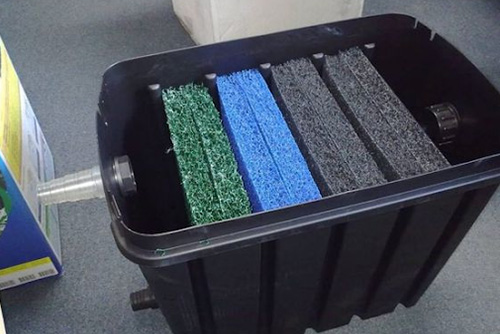
A biological filter is a vital part of aquaculture filtration to convert the produced ammonia into usable nitrogen forms so that ammonia does not rise to toxic levels and cause harm to the organisms. Thus, before setting up a bulk filter media, one needs to consider several things in order to get the best out of multiple options available out there.
A smaller biofilter is usually preferred so that it occupies less space. With size, the functions of a biofilter should not decrease and it should accomplish all the goals like reducing ammonia content, carbon dioxide, etc. A smaller size also means portability which is also important while changing the operation of the facility.
It is very important to keep in mind that the biofilter should be made of a marine-grade construction material that is UV resistant, non-corrodible, resistant to chemicals, and decaying. One good example is aquarium activated carbon bulk which acts perfectly.
The material should also have mechanical strength so that it can withstand the tough wear and tear situations underwater.
The biofilter should not be too expensive. It should come with a self-cleaning facility to ensure easy maintenance.
Above all, it is important to keep in mind that the activation of a newly installed biofilter will take time, around four weeks, to establish itself perfectly. During this time, it is important to have patience while the filter medium is getting ready and take a record of the water quality and of several water parameters daily.
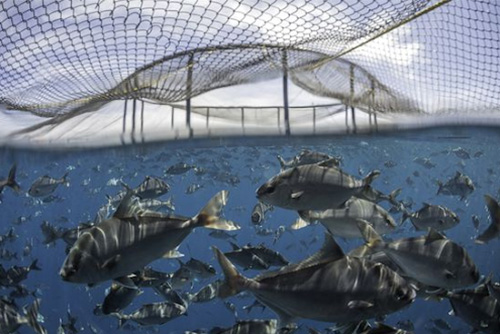
There are multiple steps in which the nitrifying bacteria should be added for starting a biofilter. Here, we have provided a step-by-step guide on how to start a biofilter from scratch.
Before the introduction of nitrifying bacteria or animal stock, it is important to make sure that the water is passing through the bio media. Next, the water chemistry should be prepared. The system water should be suited to the requirements of the stock that is being introduced.
For this, the pH, hardness, alkalinity, salinity should be managed. The temperature should also be close to the one at which the system will operate once the bacteria or stock will be introduced. Make sure that the system water is chlorine-free.
To achieve the needed alkalinity levels, carbon is added to water which supports the growth of the bacterial cells. Although the system water itself contains carbon, carbonates and bicarbonates show a better result as they can be easily managed and dissolved. Adding baking soda or sodium bicarbonate is a cheap yet good option.
When the alkalinity levels are 150 mg/L at first, they support Nitrosomonas bacteria whereas when the alkalinity is raised to 200 to 250 mg/L, Nitrobacter bacteria are established. The latter is preferred more as alkalinity can be declined to operational levels once the Nitrobacter bacteria is in place.
A pH of 6.8 to 7.2 is perfect for the medium. Also, going by the alkalinity levels that are mentioned in the previous step, pH is automatically managed but still, if the pH is at 6.8 then this could indicate a higher percentage of CO2.
This can happen when the concentration of CO2 is higher in the system water. It can be reduced by degassing or circulation of water in the system.
The next in the chain is the addition of ammonia and nitrite. For this, an aqueous solution of ammonia, ammonium hydroxide, ammonium nitrate, or ammonium chloride can be used. The desired amount of ammonia level is between 3 to 5 mg/L. Thus, add the source of ammonia accordingly.
The ammonia source should not be added all at once. Start with a small amount and wait for it to mix thoroughly, then test the concentration. You can accordingly add if there is still a need to add an ammonia source to raise the level between 3 to 5 mg/L.
Do not add too much ammonia. It is better to be a bit less than a bit more in case of ammonia levels.
The addition of nitrifying bacteria can be done by adding commercial preparations of bacteria or taking small bits of biofilter media from an active system and placing it.
For the commercial ones, they should be added as instructed and some of them may be added in a specific proportion at specific intervals of time. It is necessary to follow the directions.
For the bits from an already functional system, they can be added now.
It is necessary to regularly monitor and record the various water parameters like pH, temperature, alkalinity, the concentration of ammonia and nitrite. These parameters need to be recorded at the same time each day with the same measuring equipment and the record should be kept. A graph form is better to record the ammonia and nitrite values in a newly set-up biological filter media as it will be easy to analyze that way.
Since the animals would be kept in the culture tank, the water sample should be collected and tested from there, regularly. For testing, testing kits, spectrophotometers, or colorimeters can be used. The ammonia concentration would be higher at first but then it starts to decline. The nitrite concentration would increase after a lag period and then it declines.
Regular check on the nitrite concentration is important. The nitrite levels will decrease once the Nitrobacter bacteria have increased in number and started consuming more nitrite than what is present or added in the entire system. This will keep on declining until it reaches a minimum concentration.
At this time, the stocks can be cultured once the ammonia and nitrite levels reduce to 1 mg/L but be careful to stock slowly and keep on monitoring the ammonia and nitrite concentration. Spikes in the concentration are unlikely but if it happens, then water exchanges are needed while the cycle will continue.
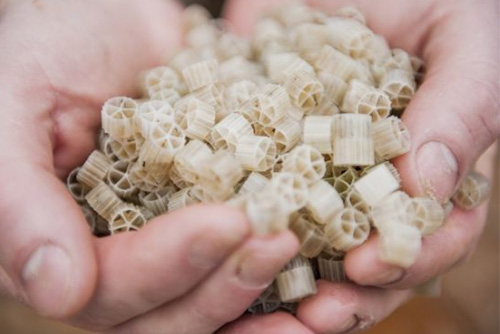
There are several types of biofilter mediums available in the market. These are discussed below.
These types of biofilters provide a surface area where the bacteria can be cultured. They can have a thick film or a thin film, depending on the water load of the environment where they are installed. For example, an aquarium filter foam bulk allows bacteria to be cultured on its surface.
Emergent filters are used for transporting a large amount of oxygen to the biofilm surface and thus they are more suitable to use in heavily loaded systems. They are larger than the submerged ones and can clog easily thus, they need to be taken care of.
Submerged filters are used where enough oxygen can be supplied to the biofilm with water. In the carbon filter aquarium, carbon does all the filtration while being submerged under the water.
Biofilter media play an equally important role in the entire functioning of a biofilter. Below are some of the most efficient bio-filter media.
These are some of the best and low-maintenance biofilter media which can quickly house a lot of nitrifying bacteria because of their efficient structure. They provide a large surface area for culturing of bacteria. These are best suited for ponds, marine, and even freshwater aquariums.
These provide a large surface area for the bacteria to live and multiply. These are also low in maintenance and have a self-cleansing property which makes them stand out. It is probably one of the best filter media for biofilters. The bio foam aquarium is another recent and effective option available.
This is another filtration medium that absorbs harmful chemicals and pesticides from the water making it safe for marine and freshwater organisms. It naturally increases the temperature too which helps in the colonization of bacteria at a faster rate. Coconut carbon is a good example.

Established in 2008, Mountain Tree in China is a leading manufacturer of reliable filter media and pond accessories. It provides a comprehensive range in aquarium filter media bulk and even filters media for ponds.
They offer ceramic filter media (spiral bacteria house, lotus root bacteria house, lotus root nitro ring, mini-ring, maifan ring, etc.), filter mats, and foams (3D filter pad, spiral filter mat, carbon wool pad, etc), and coconut carbon. Their range of accessories includes many types of filter brushes and UV sterilizers.
Do not forget to check their reliable and cost-effective range of filter media and accessories.
Setting up a biofilter for aquaculture requires as much patience as knowledge of biofilters. It is a time-consuming but crucial process required for aquaculture filtration. We have provided a step-by-step guide in this blog to help you thoroughly.
P.S. take a look at Mountain Tree, a renowned company from China, which is a one-stop location for all your filtration and monitoring system solutions. They even provide customized solutions to their clients.




Leave a Reply